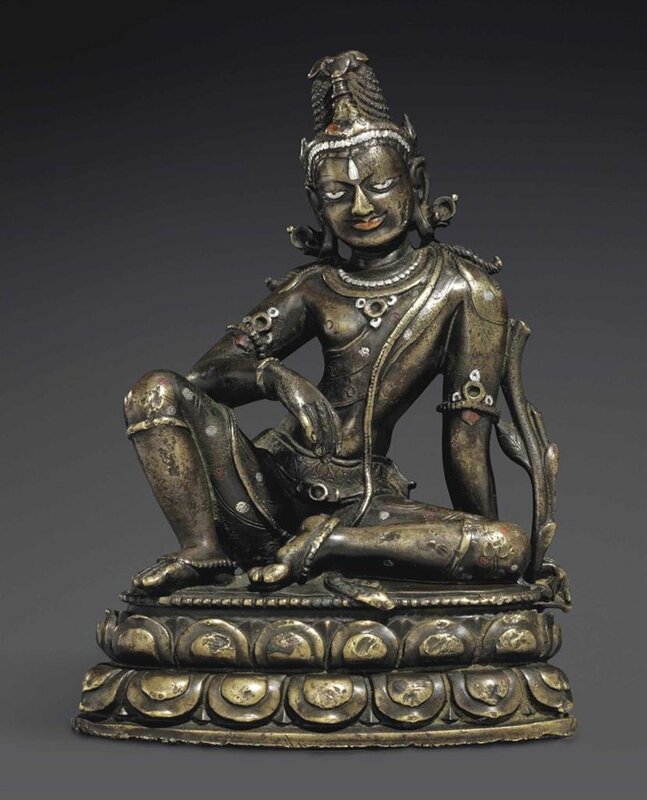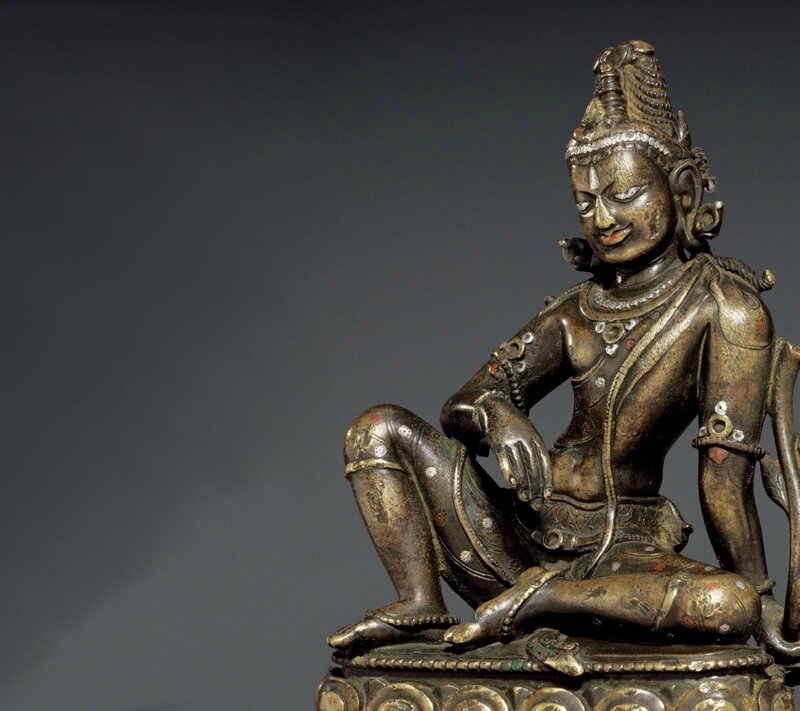A fine and rare silver-and-copper-inlaid bronze figure of Maitreya, Northeast India, Pala period, 12th century
Lot 59. A fine and rare silver-and-copper-inlaid bronze figure of Maitreya, Northeast India, Pala period, 12th century. Estimate $250,000 – $350,000. Photo Christie's Image Ltd 2016
Seated in rajalilasana on a lotus base with his right arm elegantly resting on his raised right leg while the left holds a lotus stem, clad in a dhoti and scarf richly inlaid with silver and copper medallions, adorned with silver- and copper-inlaid jewelry and a sacred thread, his face with a benevolent expression with silver-inlaid eyes and urna and copper-inlaid lips, his hair styled in a high chignon topped by a lotus knop, centered with a stupa and secured by a silver-inlaid tiara - 4 ¾ in. (12 cm.) high
Provenance: Acquired in Hong Kong in 1987
Literature: B. Khanna, et al., Human and Divine: 2000 Years of Indian Sculpture, 2000, no.29
Exhibited: Human and Divine: 2000 Years of Indian Sculpture, The New Art Gallery, Walsall, 22 July - 17 September 2000; Sainsbury Centre for Visual Arts, Norwich, 30 September - 10 December 2000; City Art Gallery, Southampton, 12 January - 25 March 2001
Notes: The Pala dynasty, which flourished from the 8th-12th century in northeastern India, was one of the last strongholds of Buddhism, as the country became increasingly Hindu by the 11th century. As Buddhism continued to flourish under the Pala rulers, there was a surge in travel among Buddhist practitioners and laypeople to sacred sites associated with Buddha Shakyamuni. With this came the expanded propagation of Buddhist texts and religious icons, which were easily transported by pilgrims. Bronze sculpture which were especially portable, played a crucial role in the propagation of Buddhist iconography throughout the region. As a result, Pala bronze work achieved an exceptional level of sophistication and to this day, is revered as one of the golden eras of the Indian sculptural tradition.
This sublime figure of Maitreya, the Future Buddha, is emblematic of the artistic mastery of Pala period bronze work. Rendered with jewel-like sensitivity, the god sits languidly atop a throne of lush lotus petals. The body is modeled with exceptional naturalism and sensuality. From the fleshy toes, to the slightly bulging belly and exaggerated curve of the torso and shoulders, every detail is rendered with a softness rarely captured in metal. The abundance of shimmering silver and copper inlay suggest this sculpture was an object of particularly special veneration. Compare with another Pala period bronze image of Maitreya in the British Museum, London (U. von Schroeder, Indo-Tibetan Bronzes, 1981, p.282-283. cat no.69D).
Christie's. THE LAHIRI COLLECTION: INDIAN AND HIMALAYAN ART, ANCIENT AND MODERN, 15 March 2016, New York, Rockefeller Plaza

/https%3A%2F%2Fprofilepics.canalblog.com%2Fprofilepics%2F1%2F0%2F100183.jpg)
/https%3A%2F%2Fstorage.canalblog.com%2F03%2F02%2F119589%2F96711876_o.jpg)
/https%3A%2F%2Fstorage.canalblog.com%2F11%2F31%2F119589%2F94773502_o.jpg)
/https%3A%2F%2Fstorage.canalblog.com%2F20%2F83%2F119589%2F94772815_o.jpg)
/https%3A%2F%2Fstorage.canalblog.com%2F26%2F72%2F119589%2F75604929_o.jpg)
/https%3A%2F%2Fstorage.canalblog.com%2F59%2F60%2F119589%2F26458628_o.jpg)




/http%3A%2F%2Fstorage.canalblog.com%2F25%2F10%2F119589%2F126675276_o.jpg)
/http%3A%2F%2Fstorage.canalblog.com%2F01%2F36%2F119589%2F122400199_o.jpg)
/http%3A%2F%2Fstorage.canalblog.com%2F61%2F10%2F119589%2F120385682_o.jpg)
/http%3A%2F%2Fstorage.canalblog.com%2F47%2F72%2F119589%2F92637725_o.jpg)